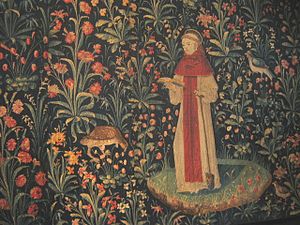Floral motif
The visual arts use floral motifs to describe allegations and themes in which plants and their details form the main motif .
Painting and graphics
In painting and graphics , the most common motifs are flowers , blossoms and tendrils, on paintings also branches and trees or plants affected by the forces of nature .
The religious painting also used allegories or depictions of monastery gardens (eg. With Mary) and the Paradise . Special flowers serve as symbols , e.g. B. the lily for chastity or virginity, the rose for love and the thorns for blood and suffering.
Other arts
The photograph expands the topic on many details, such as buds and roots , while in the sculpture occur rarely floral motifs. The Gothic sculptors and carvers are an exception : they framed many altars and biblical scenes with branches and other works of art with foliage .
Flowers, leaves and grass as well as friezes composed of tendrils predominate in the motifs of the arts and crafts . The latter is also found in architecture , for example as an anthemion or as a foliage frieze . Likewise, the capitals of columns are often decorated with plants.
Sources and web links
- José Pijoan (ed.): The art history of the world . ARTE Volume 3, Grammont-Verlag, Lausanne 1979
- Der neue Brockhaus , 3rd edition (especially Volume III on painting), Wiesbaden 1960
- Malte Jaeger: floral motifs in serial implementation of letterpress printing . Gien-Verlag 2009 online


